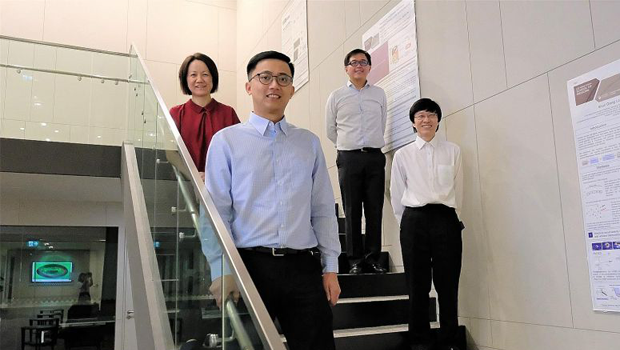
Above: The research team is led by (back row) Nanyang Technological University (NTU) Associate Professors Ling Xing Yi (in red) and Tan Nguan Soon. KK Women's and Children's Hospital Associate Professor Tan Hak Koon (in white shirt) and NTU School of Physical and Mathematical Sciences PhD student Kao Ya-Chuan are also on the team. The team has patented its invention and is looking to evaluate the performance of the toolkit in hospital settings.PHOTO: NTU SINGAPORE
Developed by local researchers test can tell in under 30 min if women with such symptoms are at higher risk
Local researchers have developed a test that can gauge a pregnancy outcome in 30 minutes or less in cases of a threat of miscarriage.
Known as threatened miscarriage, this refers to a common complication which involves abdominal pain and vaginal bleeding during the early stages of pregnancy.
One-fifth of all pregnant women here show such signs and one quarter of this group ends up miscarrying within two weeks.
The test, which was jointly developed by the Nanyang Technological University (NTU) and clinicians from KK Women's and Children's Hospital (KKH), will be able to tell women exhibiting such symptoms whether they are actually at a higher risk of miscarriage, thereby putting their minds at ease or allowing them to get help early.
In a joint news release yesterday, the institutions said that such a risk is currently detected through a blood test which measures the level of progesterone in the patient.
Such a test is invasive, requires a lab to process the results and can take a few hours before the patient gets her results back.
But a team, led by NTU Associate Professors Ling Xing Yi and Tan Nguan Soon, in collaboration with Dr Ku Chee Wai from KKH, created a test that can be carried out at a clinic in under 30 minutes without the need for a laboratory and requiring only a single droplet of urine.
Assoc Prof Ling from NTU's School of Physical and Mathematical Sciences said that molecules associated with the risk of miscarriage are typically diluted throughout the body's fluids and it is hard to detect them at low concentrations.
The newly developed test gets around this problem using a chip which is coated with a special chemical targeting agent that can isolate these molecules.
This allows the chip to detect in a single drop of urine those molecules associated with a higher risk of miscarriage: pregnane and tetrahydrocortisone.
 The researchers believe this to be the first test of its kind in the world.
The researchers believe this to be the first test of its kind in the world.
About 15 per cent to 20 per cent of pregnancies seen at KKH end up in miscarriage, a trend that has held steady over the last five years, said the chairman of the hospital's division of obstetrics and gynaecology, Associate Professor Tan Hak Koon.
Dr Ku, from the same division, said that early detection will allow pregnant women with symptoms of threatened miscarriage to receive counselling, medical interventions, or be under close medical management for adverse pregnancy outcomes throughout the rest of their pregnancy.
"It can also allay the fears and worries of pregnant women who are at low risk of miscarriage and improve their pregnancy experience," he added.
The team has patented its invention and is looking to evaluate the performance of the toolkit in hospital settings, with the aim of commercialising it in the future.
The researchers are also working on adapting the toolkit for use in other health conditions.
Assoc Prof Tan Nguan Soon, who is a metabolic disorder expert at NTU's Lee Kong Chian School of Medicine, said that the sensitivity offered by the team's test and the small sample volume required for the test to work could make it attractive for clinical use.
This is especially so for cases where it is difficult to obtain large amounts of samples, such as getting tear samples for eye disorders or breath vapour for lung diseases.
He added that the team's diagnostic platform could revolutionise the detection of molecules for medical conditions that are normally challenging to detect and "bring testing for them out of the lab and into the clinic".













 Get it on Google Play
Get it on Google Play